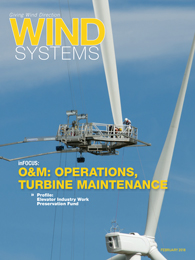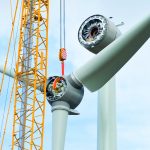Pressure from wind owners to shift from availability driven operational models to performance optimized strategies has never been stronger. The trick, however, is being able to carefully balance OPEX reduction with optimization opportunities to protect efficiency and safety portfolio wide. Importantly, efforts to optimize ever more complex sites can lead to internal frictions that have a negative effect on resources, labor performance, and budgets.
To provide some insights into the good work being undertaken across the wind industry, New Energy Update has spoken to %%0218-LW%%, vice president of Law and Deputy General Counsel at Apex Clean Energy, and her colleague, %%0218-JB%%, Health & Safety Manager to understand how they’ve been able to dramatically reduce some of these internal frictions to achieve significant cuts to injuries, site/central distrust, and expensive back office workloads across their business.
The wind industry is being urged to review relationships between legal, safety, and operational teams following pioneering work by Charlottesville, Virginia-based Apex Clean Energy.
Cutting Injury Rate
In the last two years, Apex has done away with the traditionally adversarial relations between operations and health and safety executive (HSE) and in-house legal teams, improving safety and efficiency in the process.
The change is credited with helping to cut the rate of recordable injuries by about 80 percent in the last year and reducing legal team workloads by about 50 hours annually.
In most traditional wind businesses, head office teams only visit the field to follow up on an incident, Boyle said. This can lead to feelings of mistrust that hamper cooperation and make it harder to resolve issues.
“Human resources only arrives if someone is going to get fired,” Boyle said. “Safety only arrives if there’s an injury and drug test. Legal arrives when there is a catastrophe.”
Distrust of central office functions can affect the efficiency of investigations, Weir said.
“Legal involvement post-incident imposes an unknown and formal element on a site,” she said. “The attorneys have a chilling effect on site dynamics, which increases suspicion and stifles communication so only the most necessary facts are part of the record, dis-incentivizing accountability as folks try to place blame rather than take responsibility.”
Lack of Prior Knowledge
Even in the best of situations, a lack of prior knowledge about a site can delay proceedings and contribute to an incomplete picture of events.
“Bringing attorneys in post-incident does not benefit the client as the information gained at this point may not be as accurate or complete as the attorney would learn in a real-time partnership with site safety and personnel,” Weir said. “Catching up on site facts at a critical time also drains resources, as energy is spent on fact gathering rather than using the time to advocate for a resolution.”
A further problem with the traditional approach to legal and HSE relations with field personnel is that it does little to foster the development of a low-risk safety culture.
On one hand, a reactive approach to health and safety means HSE and legal teams are unable to spot and solve problems before incidents occur.
On the other, the distrust that arises from this reactive approach may make it harder for field teams to appreciate the value of HSE and legal guidance.
“Some legal advice can appear to be a bottleneck,” Weir said. “I try to give advice and not force the resolution.”
“Reactive relationships compromise risk management for all organizations,” Boyle said. “Poor risk management leads to increased incidents and reputational and legal exposure.”
Changing the Model
Apex has changed this model by getting its legal and HSE teams to work more closely with field operations. Boyle now typically spends about 60 percent of his time in the field and speaks regularly with Weir, allowing her to provide ongoing counsel on operational matters.
Weir also sits in on a quarterly safety meeting. All this allows the legal team to provide better protection to individuals and to the business, since there is less of a risk of information being overlooked or withheld in the event of an incident.
%%0218-ACE%%
The new way of working has unearthed seemingly trivial matters that could nevertheless have created legal risks for Apex.
In one instance, Weir could advise Boyle on the correct level of safety signs Apex should use to encourage safe working without incurring a legal liability toward contractors.
One measurable result of the more proactive approach has been an improvement in the safety culture at Apex sites.
Even though Apex is not directly responsible for the safety of contractor teams, the number of recordable injuries they suffered dropped from five in 2016 down to one in 2017, despite an increase in work hours and in high-risk work.
Apex itself, meanwhile, had a recordable incident rate of just 0.43 percent across 200 employees in 2017. That compares to a rate of 1.3 percent for electric-power generation overall, based on the latest figures published by the U.S. Bureau of Labor Statistics.
Operations Improvement
Another significant improvement has been in the efficiency of operations. The proactive way of working means Weir now deals with fewer incidents and does not have to invest as much time in each one, since she is already usually aware of many of the details.
Previously, for example, if a recordable injury occurred within a contractor organization, then Weir would have to spend about 10 hours on average just getting up to speed with the details of the case. For employee injuries, the workload would be considerably higher.
Much of this time is now being saved because there are fewer incidents, and Weir has greater awareness of operations. The savings in Weir’s time alone amounted to an estimated 50 hours in 2017, she said.
Work Going Forward
Despite these improvements, Boyle and Weir said they are planning to increase the level of proactivity in their work going forward. Weir will be increasing the visibility of the legal department in the field and auditing Apex’s health and safety arrangements.
“In 2018, I have more of a directive to see the sites,” Weir said. “It’s a matter of making myself available and, in the event an incident occurs, trying to look through lessons learned and how to improve in more of a cooperative manner.”
Improving relationships is not just important for HSE and legal teams, but also for people who could be at risk in the field and, ultimately, for the managers and owners of the company.
Weir said other companies could benefit from Apex’s approach.
“I want legal teams across the industry to step up and be more proactive,” she said.
Weir has 15 years’ experience as wind energy counsel at both First Wind and Apex Clean Energy’s renewable energy businesses.
Boyle brings 15 years of experience in safety, operations, and emergency response. He was previously with Infigen, BP, The MC252 Oil Spill Response, The Pangere Corporation, and U.S. Steel where he held safety leadership positions.
Apex Clean Energy is a major renewable energy company with a 2.2GW operating portfolio, more than 3GW of financed clean energy projects and a further 1.5GW under management
Boyle and Weir will be presenting on Apex’s proactive approach to legal and HSE relations at the 10th Annual Wind Operations Dallas 2018 conference April 16-18 at the Westin Galleria in Dallas, Texas. Contact organizer Kerr Jeferies at kerr@newenergyupdate.com or call +44 (0) 207 375 7565 for more information.




































